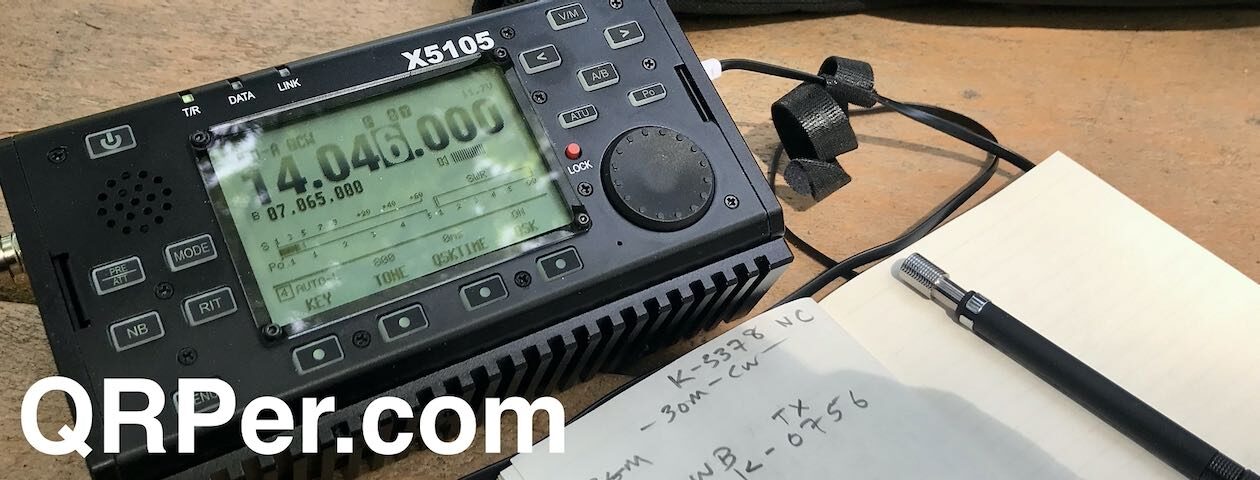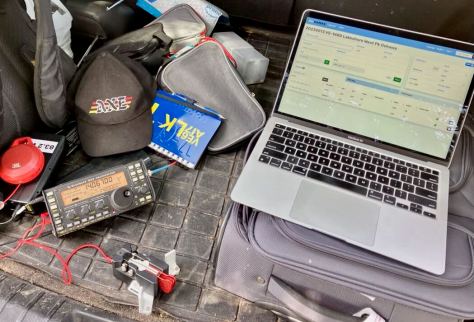 This past week, I posted the third of several surveys on QRPer.com, this time asking:
This past week, I posted the third of several surveys on QRPer.com, this time asking:
“What QRP HF transceiver would you or do you choose for air travel?”
I turned off the survey at 6:30 EDT today, with a total of 475 responses.
Survey Results
Here’s a pie chart showing the top 18 results in the survey. To see detail, you will need to click on the image below (or click this link) to enlarge it in a new window:

The top choice was the Elecraft KX2 which accounted for 22.9% of the votes.

It’s funny: I had assumed the Icom IC-705 might take first place in this survey. Then I realized that I own both the KX2 and IC-705 and, this summer, I chose the KX2 each time I traveled. Indeed, I can’t think of a time in recent memory that I didn’t take the KX2 with me during travels.
The reason I picked the KX2 each time is because it’s such a comprehensive HF radio with a superb built-in ATU and battery pack. There’s no field situation I can throw at it that it can’t handle. In fact, if a site doesn’t allow any antennas on the ground, I can even pair it with my AX1 or AX2 tabletop antennas.
I see why so many of you picked it as your first choice.
Your second choice was the Icom IC-705 which accounted for 14.3% of the votes.
 The IC-705 has one very cool feature for travel: you can charge it with a common Micro USB charger!
The IC-705 has one very cool feature for travel: you can charge it with a common Micro USB charger!
No need to take a separate power supply, battery pack, or custom charger. Simply bring a Micro USB cable and plug it into the hotel USB charger, your phone’s charger, or even a Lithium power pack. If you’re happy with 5 watts of output power, you really need no other battery, power supply, or charger.
Of course, the IC-705 is compact, sports the entire HF band, VHF, and UHF and is multimode. It can also receive FM and AM broadcasts along with weather radio, and the AIR band.
You can even do D-Star natively and allow the GPS in the IC-705 to find the closest repeaters and load them to memory.
The IC-705 is a very savvy travel transceiver!
Your third choice was the Yaesu FT-817/818 which accounted for 9.9% of the votes.

At first, I was a little surprised the FT-817/818 would gather more votes than, say, the Elecraft KX3, but then again it’s actually a very compact radio. I remember when I used to travel Europe for a living, I would tuck my FT-817 into my carry-on and I hardly noticed it was there.
It also ships with a NiMH battery pack, and you can also buy a much longer-life and faster-charging Li-Ion pack.
The FT-817/818 is a rugged radio. You don’t have to worry about it being harmed in a pack and it lays pretty flat as well so it’s easy to protect and pad among your clothes.
The Elecraft KX3 took forth place with 8.6% of the votes.

The KX3 is one of the highest-performance field radios ever made and it is incredibly portable.
I added the Side KX panels to my KX3 many years ago. With those installed and using the Lexan cover, it’s a very rugged radio. Simply toss it on your flight bag and you’re good to go!
The KX3 is also a very efficient radio, so you could easily power it with, say, a $25 Talentcell USB battery pack–one that TSA wouldn’t blink at.
I’ve traveled pretty extensively with my KX3 so I see why it ranks so high on the list. Like its newer sibling, the KX2, it has an amazing internal ATU. You can also load the KX3 with AA cells for short on-the-air sessions or longer listening sessions.
Fifth on this list of travel radios is the Xiegu X6100 which accounted for 6.1% of the votes.

No doubt, what makes the X6100 so appealing is that, like the KX2, it’s a proper shack-in-a-box. Indeed, I would also add the X5105 to this same list.
The X6100 contains a high-capacity rechargeable internal battery pack and an excellent ATU. It’s an all-in-one radio solution that’s actually quite rugged and could easily handle the bumps and jolts of air travel.
Notable mention…
There was another winner in this survey. It wasn’t any one model, but rather a whole class of HF transceivers: super compact portable transceivers. If lumped together as a category, these would have placed in the top five.

I’m talking about radios like the: Mountain Topper series, QCX-Mini, QMX, QDX, SW-3B, (tr)uSDX, TR-25, TR-35, and similar. These radios are so incredibly tiny that they can be packed away in a very compact pouch.

Indeed, I have a complete dedicated POTA/SOTA station built around my Venus SW-3B (see photo above). It’s all contained in a small BROG headrest pouch that I could easily toss in a travel bag.
These pint-sized radios aren’t general coverage radios like the top 5 listed above, and many are CW-only. Still: if your goal is to hit the field a bit during your vacation, they’re incredibly effective.

This radio class also represents some of the most efficient and affordable transceivers on the market.
Full Results…
If you would like to see the actual number of votes for each of the 48 radios in this survey, click the link below to load the rest of the page:
- Elecraft KX2: 109 votes
- Icom IC-705: 69 votes
- Yaesu FT-817 or FT-818: 47 votes
- Elecraft KX3: 41 votes
- Xiegu X6100: 29 votes
- lab599 Discovery TX-500: 27 votes
- Xiegu G90: 20 votes
- (tr)uSDX: 15 votes
- Elecraft K2: 11 votes
- Penntek TR-35: 10 votes
- FX-4C, FX-4CR or FX-4L: 9 votes
- Venus SW-3B: 9 votes
- Elecraft KX1: 8 votes
- Mountain Topper MTR-3 series: 8 votes
- QRP Labs QCX-Mini: 8 votes
- The following received less than 7 votes
- Icom IC-703
- Mountain Topper MTR-4 series
- Xiegu X5105
- QRP Labs QCX
- QRP Labs QDX
- uBITX transceiver (any model)
- Xiegu G106
- Elecraft K1
- Pentek TR-45L
- Hendricks PFR 3 series
- YouKits or Ten-Tec Branded 2-4 band CW QRP Transceiver
- Flex Radio Flex 1500
- M0NKA mcHF
- Penntek TR-25
- Xiegu G1M
- Hamqrpkits EGV+
- Expert Electronics SunSDR2 QRP
- Hermes-Lite 2
- DSW-20
- QRP-Labs QMX
More QRP radio surveys on the way!
 What did you think about these results? Was your choice in the top five? Feel free to comment!
What did you think about these results? Was your choice in the top five? Feel free to comment!
Also, stay tuned as I have quite a few QRP radio survey questions in the works.
I’ve tagged all of these reviews so they’re easy to browse, just bookmark or note: QRP Radio Survey Series.

















































